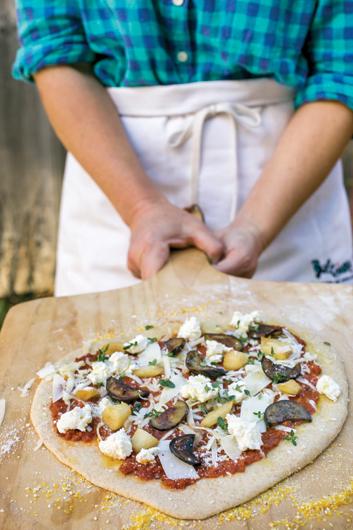
This pizza recipe combines a great dough, lots of topping ideas (and proportions), and directions for assembling and baking. A pizza stone (and a very hot oven!) will give you the best results and a pizza peel will make transfering the pizza to the oven much easier. (Be sure to put your dough on top of your peel before topping!) But before beginning, you should be sure all to read all of the tips in the feature which originally accompanied this recipe in Martha's Vineyard magazine: All We Are Saying is Give Pizza a Chance.
Editors' note: We have recently tested this recipe using a cast-iron pan to cook the pizza instead of a pizza stone. Scroll to the end of this recipe for tips on how to try this variation if you are intrigued. You will not need a pizza stone or a pizza peel - just an 8-inch or 10-inch cast iron pan and extra olive oil.
Makes 4 personal pizzas, or 8 mini pizzas if you divide each dough ball in two and adjust the directions and amounts accordingly.
For assembling:
- 1 recipe Simple and Quick Food Processor Pizza Dough (4 personal dough balls), proofed
- Coarse cornmeal
- Flour
For the seasoned oil:
- 1/3 cup extra-virgin olive oil, more for drizzling
- 1 tablespoon plus 1 teaspoon fresh garlic, minced
- 1/4 teaspoon crushed red pepper flakes (optional)
- A few pinches of lemon zest (optional)
For the red sauce (optional):
- 1 to 1½ cups Roasted Tomato sauce , other homemade (thick) tomato or pizza sauce, or purchased pizza sauce
For base cheese layer:
- 2 to 2½ cups fontina cheese, grated
- ¾ cup Parmigiano Reggiano, coarsely grated
For toppings (including other cheese):
- 3 to 5 choices from topping sidebar (BELOW)
- Kosher or sea salt
- Olive oil or infused oil for drizzling
- 1 to 2 tablespoons fresh herbs, roughly chopped (any kind, use less of woody herbs like rosemary and thyme)
- 1 cup baby arugula, baby kale, micro greens, or other tender fresh greens (optional)
1. Put a baking stone on the lowest rack of your oven and heat the oven to 500 degrees.
2. Make the seasoned oil: combine the oil, garlic, red pepper flakes (if using), and lemon zest (if using) in a small bowl and stir to combine. Set aside with a pastry or basting brush (or small spoon).
3. Combine the fontina and the Parmigiano in another bowl. Arrange the seasoned oil, the cheeses, your toppings, salt, and a bottle of olive oil or infused oil near your work area.
4. Sprinkle a pizza peel or the back of a large cookie sheet with cornmeal. Lightly flour a work surface, your hands, and a rolling pin. Gently press one dough ball out with your fingers and hands until it forms a flat cake on your work surface. Using the rolling pin, roll the dough out to a 9-inch circle. If the dough is bouncy, let it rest between rolls.
5. Transfer the rolled dough to the pizza peel or baking sheet.
6. Spoon about one scant tablespoon of the seasoned oil (including the garlic, etc.) onto the dough and brush or use the back of a spoon to spread it all over the dough, leaving a 3/4-inch border around the edge. If using red sauce, spoon about 1/4 of it over the oil. Next, sprinkle on a few tablespoons of the fontina-Parmigiano mixture (do this directly over the oil if not using red sauce). Arrange, dollop, or sprinkle a quarter of your other toppings in any order you like over the dough. Finish with one or two more tablespoons of the fontina-Parmigiano mixture. Sprinkle on a small amount of the fresh herbs, drizzle the whole pizza with a little olive oil or infused oil (or a small amount of the seasoned oil), and sprinkle with kosher salt or sea salt.
7. Transfer the pizza to the oven and cook until the crust is golden brown around the edges and crisp and golden on the bottom (check with tongs), 8 to 10 minutes. (The dough will be more bread-like at 8 minutes; more cracker-like at 9 or 10 minutes.) Use the peel (or tongs and a baking sheet) to transfer the pizza to a wooden cutting board. Top with fresh greens or more fresh herbs if desired. Slice and serve.
8. Repeat with remaining dough and toppings.
This recipe was originally published with the article, All We Are Saying is Give Pizza a Chance.
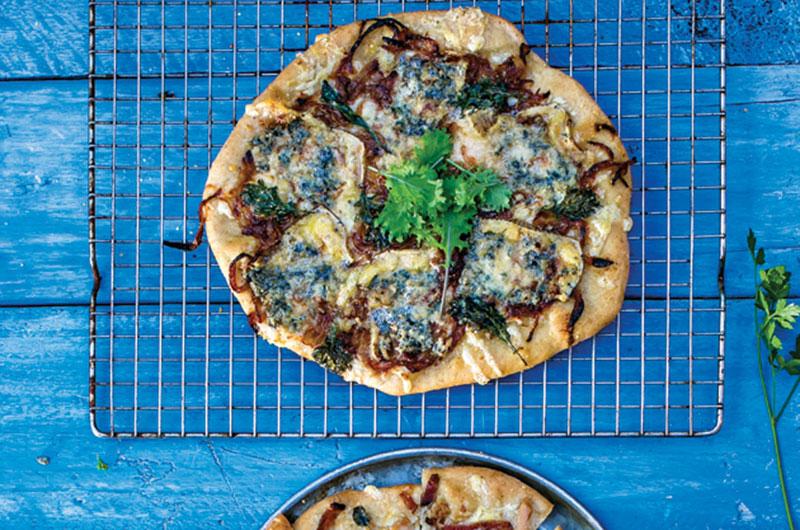
Topping Suggestions
I suggest choosing between three to five toppings (one or even two of which can be another cheese), preferably from more than one of the different categories (creamy, salty, savory, sweet), to create some interesting contrast. You also have the option of finishing with fresh greens or fresh herbs after the pizza comes out of the oven, so consider that when pairing flavors. For instance, spicy arugula is a great foil for a combination of salty blue cheese and sweet caramelized onions. Salty ingredients like anchovies or capers play well with savory roasted or sun-dried tomatoes and a light, creamy cheese like fresh mozzarella or ricotta. For savory toppings, bear in mind that while some veggies can go on raw, you’ll get a much tastier topping if you cook many of them, such as mushrooms and eggplants. Meat toppings like sausage, ground meat, and bacon should also be cooked first. Delicate cured meats like prosciutto can actually go on after the pizza comes out of the oven.
The amounts suggested are total amounts for four pizzas – just so you’ll have a ballpark to aim for when shopping and prepping. Don’t be tempted to overload your pizza, and don’t be afraid to go very simple, either. More isn’t necessarily better!
Creamy
(Between 4 and 8 ounces total for 4 pizzas)
- Brie
- Crème frâiche
- Feta
- Goat cheese, fresh or aged
- Grey Barn Prufrock
- Grey Barn Rip Rap
- Gruyère
- Fresh mozzarella balls (I like the small ciliegine), sliced
- Mermaid Farm Fromage blanc
- Mermaid Farm gouda or other young or aged gouda
- Ricotta
Salty
(Use sparingly, between 2 tablespoons and 3 to 4 ounces total for 4 pizzas)
- Bacon or pancetta, cooked
- Blue cheese (such as Grey Barn Bluebird)
- Capers, roughly chopped if large
- Clams, chopped
- Olive tapenade
- Olives, pitted
- Pepperoni or very thinly sliced salami
- Pesto (basil or Pam’s Sun-Dried Tomato Pesto)
- Prosciutto, thinly sliced (top after cooking), or other thinly sliced cured meat
- Smoked fish (trout, bluefish, or salmon), shredded or thinly sliced
Savory
(Meat, fish, and vegetables; 3/4 to 1 1/4 cups total for 4 pizzas)
Visit Island meat farms to give your pizza local flavor: Beetlebung Farm, Blackwater Farm, The Good Farm, Grey Barn, Cleveland Farm, Morning Glory Farm, Mermaid Farm.
- Chicken, lamb, or pork sausage, cooked
- Collards, kale, or broccoli rabe, blanched or very thinly sliced and tossed in oil
- Corn kernels, raw
- Beef, lamb, or pork (ground), cooked
- Beef or pork ribs, cooked and shredded
- Chicken, roasted and shredded
- Duck, roasted and shredded
- Eggplant, sliced thinly and roasted or sautéed
- Kale (baby), raw and tossed in oil
- Mushrooms (cremini, shiitake or other), sliced and sautéed
- Peppers, sliced thinly and sautéed
- Potatoes (baby red or gold, fingerling), raw and very thinly sliced or blanched and diced
- Squid, raw, thinly sliced, and tossed in oil
- Spinach, wilted
- Sweet potatoes, diced and blanched or briefly sautéed
- Tomatoes (roasted or sun-dried), sliced
Sweet
(Use about ¾ cup total for 4 pizzas)
- Bay scallops, raw
- Caramelized onions, leeks, shallots, or fennel bulb, thinly sliced and sautéed slowly
- Garlic, roasted
- Apples, thinly sliced and sautéed
- Figs (fresh), sliced
- Pears, thinly sliced and briefly sautéed
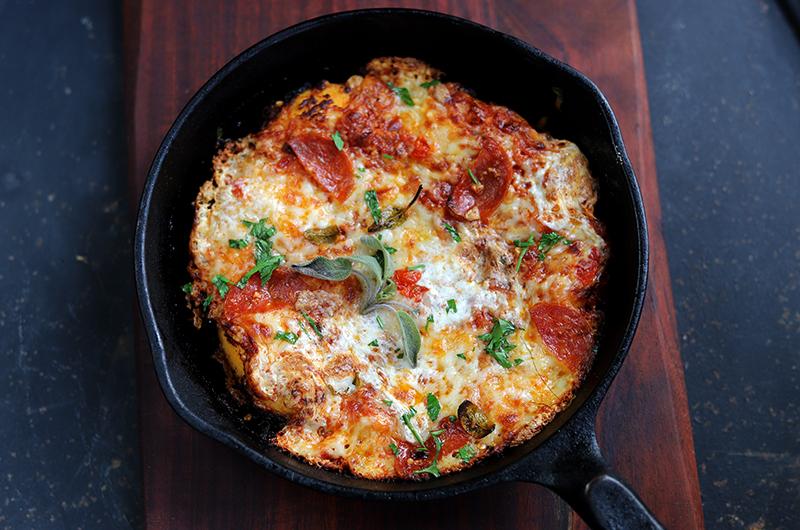
Variation: Cast Iron Pan Pizza
Cooking a pizza in a cast-iron pan has a few perks:
- Texturally, the bottom of the pizza will be pleasantly crusty as it will have fried in the olive oil in the pan.
- You will not need a pizza stone or pizza peel to make pizza – just an 8-inch or 10-inch seasoned cast-iron pan.
- Topping is easier as you top the dough after it goes into the pan.
One word of caution: Your cast-iron pan should be as hot as possible to mimic the heat of a hot pizza stone. So you’ll want to preheat the pan in your hot oven. That means being careful when moving the pan out and back in the oven. Leave a potholder around the hot handle while it is out of the oven. You’ll also want the oil in the pan to get hot before adding the dough. If you pay close attention, you can add the oil to the pan during the last minute or so of pre-heating it in the oven. (But don’t leave the oil in there for long or it will smoke.) Alternatively, you can add the oil to the pan right when you take it out of the oven; swirl it around and let it get hot before adding the dough.
How to proceed:
- Follow the dough recipe as written. Divide the dough into 6 pieces if you are using an 8-inch cast-iron pan, 4 if using a 10-inch pan. Proof and let rise using dough directions.
- Heat oven to 500 degrees, as in recipe above.
- When ready to start making pizzas, put your pan (or pans) into the oven to heat through, 10 to 15 minutes. Remove the pan from the oven and add 2 to 3 teaspoons (for an 8-inch pan) or 4 to 5 teaspoons (for a 10-inch pan) of olive oil to the pan. Swirl to let the olive oil heat through.
- Roll out one dough ball, per the recipe, to a 7-inch disk for the 8-inch pan or a 9-inch disk for the 10-inch pan (or whatever size will fit in your pan).
- Transfer the disk to the pan and top per the recipe above.
- Put the pan in the oven and cook for 12 to 16 minutes, depending on size. Begin checking the bottom of the pizza with a small metal spatula after about 11 minutes. (These are approximate times – you will have to see by trial and error what works for you in your oven. We used an 8-inch pan and found that the 12-minute pizza was ever so slightly underdone and the 14-minute pizza was very crisp on the bottom and thoroughly cooked through.)
- Carefully remove the pan from the oven and keep the potholder on it while you transfer the pizza to a cutting board. (You can let it sit for a few minutes before transferring if you like.) There may be a little sticking on the sides due to melting cheese, but this is easily dislodged with a spatula or a knife. Cut and serve.
- Wipe out the pan and reheat it in the oven before cooking another pizza.

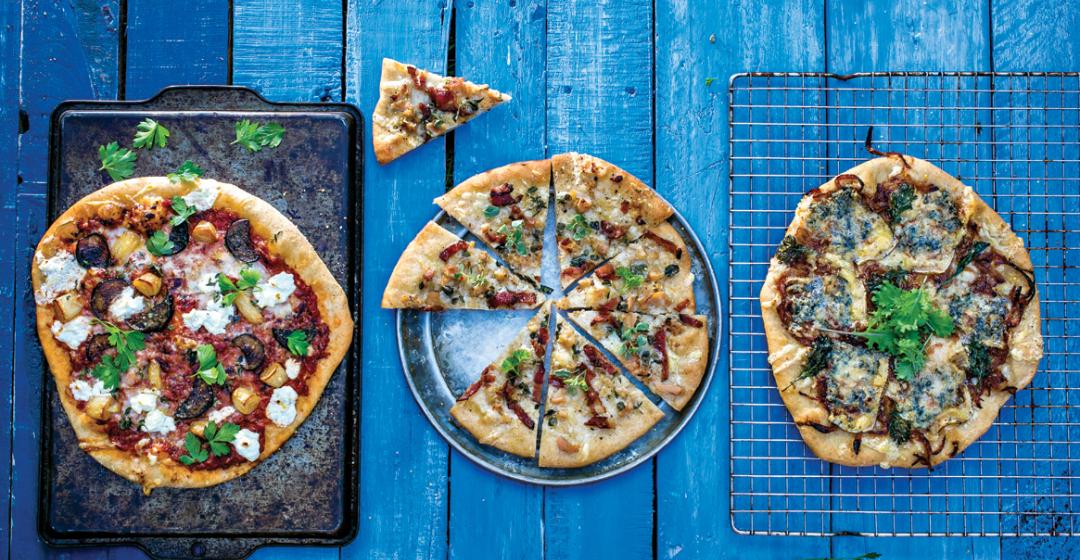


 2 comments
2 comments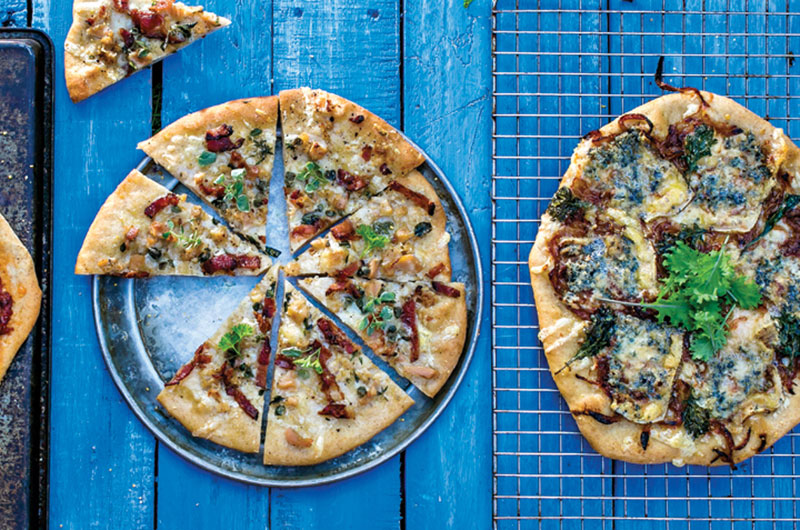



Comments (2)